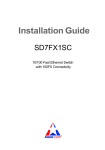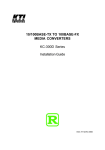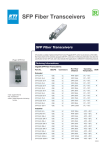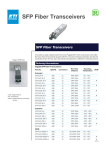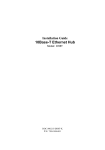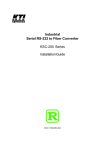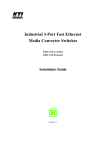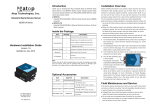Download KTI Networks Nway switch fiber 10/100, Fx
Transcript
Installation Guide 10/100 Fast Ethernet Switch with 100FX Connectivity KS-105F Series DOC.060302-KS105F -1- (C) 2005 KTI Networks Inc. All rights reserved. No part of this documentation may be reproduced in any form or by any means or used to make any directive work (such as translation or transformation) without permission from KTI Networks Inc. KTI Networks Inc. reserves the right to revise this documentation and to make changes in content from time to time without obligation on the part of KTI Networks Inc. to provide notification of such revision or change. For more information, contact: United States International KTI Networks Inc. P.O. BOX 631008 Houston, Texas 77263-1008 Phone: Fax: E-mail: WWW: 713-2663891 713-2663893 [email protected] http://www.ktinet.com/ Fax: E-mail: WWW: 886-2-26983873 [email protected] http://www.ktinet.com.tw/ -2- The information contained in this document is subject to change without prior notice. Copyright (C) All Rights Reserved. TRADEMARKS Ethernet is a registered trademark of Xerox Corp. FCC NOTICE This device complies with Class B Part 15 the FCC Rules. Operation is subject to the following two conditions: (1) This device may not cause harmful interference, and (2) this device must accept any interference received including the interference that may cause. CE NOTICE Marking by the symbol indicates compliance of this equipment to the EMC directive of the European Community. Such marking is indicative that this equipment meets or exceeds the following technical standards: EMC Class B EN 50081-1/1992 : EN55022, EN61000-3-2, EN61000-3-3 EN 50082-1/1998 : EN61000-4-2, EN61000-4-3, EN61000-4-4, EN61000-4-5, EN61000-4-6, EN61000-4-8, EN61000-4-11 -3- Table of Contents 1. Introduction .................................................................. 5 1.1 Features ........................................................................................... 6 1.2 Specifications .................................................................................. 7 2. Installing the Switch ..................................................... 9 2.1 Unpacking ....................................................................................... 9 2.2 Checking AC Power ......................................................................... 9 2.3 Installing the Switch ...................................................................... 10 3. Making Network Connections .................................. 11 3.1 Switched Ports ............................................................................... 11 3.2 Making UTP Connections ............................................................. 11 3.3 Making Fiber Connection .............................................................. 12 4. LED Indicators ........................................................... 14 4.1 LED Panel ....................................................................................... 14 4.2 Interpretation ................................................................................. 14 -4- 1. Introduction This 5-port Fast Ethernet switch series provides four 10/100 TP ports and one 100BASE-FX fiber port, each capable of transmitting or receiving information simultaneously at full wire speed to control and allocate the network bandwidth. The key features of the switch series are: • Optimized Bandwidth : Combining five 100Mbps-based Fast Ethernet switched ports, the switch delivers a high network bandwidth for your Fast Ethernet network • Easy Migration : With 10BASE-T support on each port, the switch provides a non-disruptive and smooth migration path from Ethernet to a Fast Ethernet network. • Fiber Uplink Support : With 100BASE-FX port, the switch provides a connectivity to a Fast Ethernet network via fiber cable. • Easy Installation : With the functions of auto-speed-sensing and auto-negotiation on each port, the switch supports plug-and-play installation which eliminates configuration problems. -5- 1.1 Features Designed for resolving congestion problems caused by bandwidth-hungry devices and bandwidth-intensive applications as well as a high number of users, the switches not only adhere to the IEEE 802.3 10BASE-T, 802.3u 100BASE-TX and 100BASE-FX standards, but also feature: • • • • • • • • • • Four 10/100BASE-TX auto-negotiation switched ports and one 100BASE-FX port for flexible connections to desktop PCs, servers and Fast Ethernet devices. The 10/100BASE-TX switched ports support: - auto-negotiation with auto-negotiation devices - full-duplex or half-duplex operation - automatic MDI/MDI-X configuration For the 100BASE-FX fiber port, the switch series support variety of fiber connectors for different application needs. The fiber connectors include ST, SC, MT-RJ, and VF-45 types for multimode and single mode fiber cables. Supports duplex mode selector for the 100BASE-FX fiber port. Self learning for active MAC addresses and address aging Store and forward switching to ensure only good packets are forwarded Forwarding and filtering at full wire speed Supports IEEE 802.3x flow control for full-duplex operation Supports back-pressure flow control for half-duplex operation Comprehensive LED indicators provide quick, easy to read port and switch information -6- 1.2 Specifications 10/100 Ports IEEE 802.3 10BASE-T, IEEE 802.3u 100BASE-TX std. Shielded RJ-45 jacks with Auto MDI-X detection Auto-negotiation capable Speed for 10Mbps or 100Mbps Full-duplex or half-duplex mode support 100FX Port IEEE 802.3u 100BASE-FX compliant Fixed 100Mbps operation Duplex mode selector - full duplex or half duplex Flow control IEEE 802.3x pause packet for full duplex operation Back-pressure for half duplex operation Cables 10BASE-T Cat. 3, 4, 5 or higher (100 meters max.) 100BASE-TX Cat. 5, 5e or higher (100 meters max.) 100BASE-FX multimode or single mode fiber cable LED indicators Power status Per port : Speed, Link, Activity, Duplex, Collision status Forwarding rate 14,880 pps for Ethernet (10M) 148,800 pps for Fast Ethernet (100M) Filtering address Multicast/Broadcast/Unicast address MAC address 1K entries Aging time 300 seconds Environment Temperature -5oC to 40oC Relative humidity 10% to 90% non-condensing Dimensions 144 mm x 104.5 mm x 26 mm (WxDxH) 5.67 x 4.11 x 1.02 inch DC IN Jack Rating +7.5V/1A, D6.3mm DC IN voltage Operating +6.0V ~ +12.6VDC (Device DC Input) Consumption DC input power consumption 3.9W @+7.5V -7- D2.0mm 100FX Port Fiber Specifications Duplex Series Model KS-105F-T KS-105F-C KS-105F-JM KS-105F-VM KS-105F-SA2 KS-105F-SL2 KS-105F-SL3 KS-105F-SL4 KS-105F-SL6 KS-105F-SL7 KS-105F-SL9 KS-105F-SL10 KS-105F-SL12 Fiber Wavelength ST MMF 1310nm SC MMF 1310nm MT-RJ MMF 1310nm VF-45 MMF 1310nm SC SMF 1310nm SC SMF 1310nm SC SMF 1310nm SC SMF 1310nm SC SMF 1310nm SC SMF 1310nm SC SMF 1310nm SC SMF 1550nm SC SMF 1550nm Tx Power -19 ~ -14dBm -19 ~ -14dBm -19 ~ -14dBm -20 ~ -14dBm -15 ~ -8dBm -15 ~ -8dBm -15 ~ -8dBm -5 ~ 0dBm -5 ~ 0dBm -3 ~ +3dBm 0 ~ +5dBm -3 ~ +3dBm 0 ~ +5dBm Sens. Ref.Distance -31dBm 2km -31dBm 2km -31dBm 2km -31dBm 2km -31dBm 20km -32dBm 20km -34dBm 30km -34dBm 40km -35dBm 60km -37dBm 70km -37dBm 90km -37dBm 100km -37dBm 120km Ref. Distance : reference distance when operating on full duplex mode MMF : Multimode fiber - 62.5/125µm, 50/125µm SMF : Single Mode fiber - 9/125µm Single Fiber Bi-Di WDM Series Model Fiber Wavelength KS-105F-W3515 SC SMF Tx 1310nm Rx 1550nm KS-105F-W5315 SC SMF Tx 1550nm Rx 1310nm KS-105F-W3540 SC SMF Tx 1310nm Rx 1550nm KS-105F-W5340 SC SMF Tx 1550nm Rx 1310nm Tx Power -14 ~ -8dBm Sens. Ref.Distance -31dBm 15-20km -14 ~ -8dBm -31dBm 15-20km -8 ~ 0dBm -34dBm 40km -8 ~ 0dBm -34dBm 40km Single Mode CWDM Series Model KS-105F-CxxW40 KS-105F-CxxW80 Fiber Wavelength Tx Power Sens. Ref.Distance SC SMF Tx 1xx0nm -5 ~ 0dBm -35dBm 40km Rx 1100-1650nm SC SMF Tx 1xx0nm 0 ~ +5dBm -37dBm 80km Rx 1100-1650nm Tx 1xx0nm : 1470, 1490, 1510, 1530, 1550, 1570, 1590, 1610nm -8- 2. Installing the Switch 2.1 Unpacking Check to see that you have everything before you start the installation. • Installation guide • The switch unit • One AC power adapter for the unit 2.2 Checking AC Power Before you begin the installation, check the AC voltage of your area. The AC power adapter which is used to supply the DC power for the unit should have the AC voltage matching the commercial power voltage in your area. The specifications of the AC power adapter are: • • AC input power: DC output power: • DC plug type: AC power voltage of your area +7.5VDC 1A min. -9- The DC power jack for the AC power adapter is located on the rear of the switch as shown below: 2.3 Installing the Switch 1. Install the switch with the AC power adapter provided. 2. Connect the power adapter cable to the switch before connecting the adapter to the AC outlet. -10- 3. Making Network Connections 3.1 Switched Ports The following figure shows the locations of the switched ports: 3.2 Making UTP Connections 10/100 TP Port Configuration All 10/100 TP ports support configuration as follows: Auto-negotiation capable Highest capability : 100M Full duplex Speed : auto-sensing for 100Mbps or 10Mbps Duplex : Full duplex, Half duplex Auto MDI-X function The following table lists the configuration used for the 10/100 port when it connects to different devices: Connected Device 10BASE-T hub port 100BASE-TX hub port Auto-negotiation port Non-auto*1 half-duplex port Non-auto full-duplex port Configuration Used 10Mbps, half-duplex 100Mbps, half-duplex Determined via auto-negotiation process auto-speed-sensing *2, half-duplex Not supported *1 Non-auto : non-auto-negotiation *2 speed is determined by auto-sensing function -11- Cables Depending on the connection speed, use the proper UTP cables: Speed 100M 10M Cables used Distance Cat. 5, 5e, or higher grade 100 meters Cat. 3, 4, 5, 5e, or higher grade 100 meters Auto-MDI-X Function An Auto-MDI-X function will automatically detect if a crossover is required and make the swap of Tx pair and Rx pair internally. With this function, straight-through cable can be used for any connection. MDI to MDI-X connection rule is not necessary anymore. In the switches, all TP ports are equipped with this function. You can use just straight-through type of cables for all your connections. 3.3 Making Fiber Connection For different fiber connections, several alternative models can be selected for different fiber connections. Refer to Section 1.2 for the model selection. The following figure illustrates a connection example between two SC fiber ports: -12- 100FX Duplex Selector This selector is used for 100FX port duplex mode selection as follows: The following table lists the maximum MM fiber cable length connecting to different devices: Connected Device Network card half-duplex fiber port Network card full-duplex fiber port Class I hub half-duplex fiber port 2 Class II hub half-duplex fiber port Switched half-duplex fiber port Switched half-duplex fiber port -13- Distance (MMF cable) 400 m 2 km 160 m 112 m 400 m 2 km 4. LED Indicators 4.1 LED Panel The switch provides comprehensive LED indicators for diagnosing and monitoring the operation of the switch as illustrated below: 4.2 Interpretation LED Functions POWER LED : indicates the power status of the switch. LNK/SPD/ACT LED : indicates the link status, connection speed status, and traffic status of the switched port DUP/COL LED : indicates the duplex status and collision status of the switched port LED States and Indications LED POWER POWER State & Color Off -------On Green LNK/SPD/ACT LNK/SPD/ACT LNK/SPD/ACT LNK/SPD/ACT LNK/SPD/ACT On On Blink Blink Off Green Amber Green Amber -------- DUP/COL DUP/COL DUP/COL On Green Off -------Blink Green Indication No power is supplied to the switch. Power is being supplied to the switch. Speed 100M, link up Speed 10M, link up Speed 100M, link up, Tx/Rx activities Speed 10M, link up, Tx/Rx activities Link down Full duplex mode Half duplex mode, no collision Half duplex mode, collisions -14-














